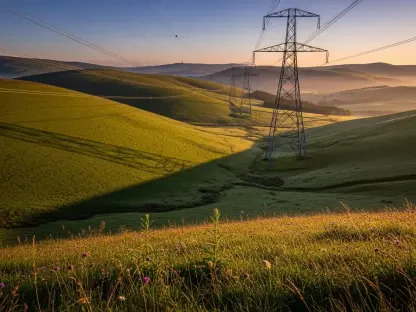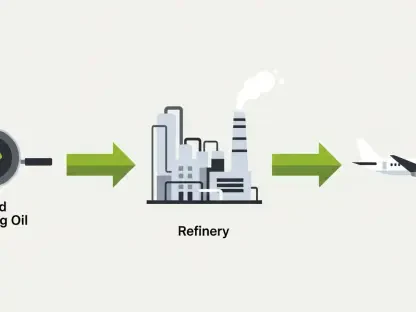The intricate dynamics of Kazakhstan’s renewable energy sector are being significantly reshaped by China’s growing involvement. From technology suppliers to independent developers, Chinese companies are moving toward bolstering their presence, thus playing a pivotal role in redefining the energy landscape of Central Asia. This market analysis delves into current patterns, examines key players, and forecasts future trends in this evolving sector.
China’s Strategic Transition in the Renewable Energy Sector
China’s journey in Kazakhstan’s renewable energy market illustrates a strategic evolution from technology suppliers to leading independent developers. With extensive backing from Chinese development institutions, firms like Universal Energy have embarked on major projects independently. This shift emphasizes China’s broader ambition to cement its role in the global renewable energy arena, highlighted by its status as the top exporter of wind turbines and solar panels. This transformation within Chinese firms underscores a pivotal change that aligns with China’s Belt and Road Initiative, focusing on sustainable energy projects.
Initially, Kazakhstan’s renewable energy initiatives were characterized by modest projects engaging local and international stakeholders. Chinese entities predominantly served as partners, facilitating technology transfers through collaborations. With China providing crucial financial support, the Belt and Road Initiative emerged as a cornerstone, amplifying the scale and ambition of these initiatives. This transition highlights China’s strategic deployment of soft power, leveraging its wealth and experience to influence energy reform in Central Asia.
Analyzing the Diverse Player Dynamics in Kazakhstan
Kazakhstan’s renewable energy landscape is marked by a diverse array of participants, each contributing distinctively to the sector’s momentum. Four main groups stand out: prominent Kazakh entrepreneurs, foreign companies, major industrial firms, and a range of independent businesses. Local entrepreneurs, often influential figures across various industries, initiate projects by tapping into foreign technology and investment, particularly from China. These collaborations are instrumental in driving large-scale renewable ventures.
Foreign firms are making notable strides independently, unburdened by local partnerships. Companies such as Universal Energy illustrate a new era of purposeful investment as they establish substantial projects on their own. Industrial giants, most notably within the mining and oil sectors, are driven by international sustainability standards to prioritize renewable energy investments. As a result, they are adapting their ventures to align with environmental objectives, pointing to a significant realignment of corporate goals.
Moreover, independent entities like Divitel inject diversity into the market by launching innovative initiatives without apparent affiliations. This eclectic mix of participants broadens the scope of renewable energy development, fostering a competitive and inclusive market ethos. These unique contributions from a multitude of players mark a period of rich diversity and collaboration within the sector.
Detailed Insights into Major Projects and Market Shifts
Recent developments reflect an evolving emphasis on large-scale projects within Kazakhstan’s renewable energy sector. The Sarkylmas Kuat Wind Power Plant, with a capacity of 50 MW, stands as the paramount new project spearheaded in the Karakiya district. Chinese company Universal Energy’s installation of wind turbines here, devoid of local intermediary partnerships, signifies a crucial advancement in Chinese autonomy and technological prowess.
Further illustrating this progression, the Aisha Solar Power Plant expanded its capacity, while the China Huadian Corporation mapped out further initiatives. These project implementations showcase a blend of continuity and change, where traditional strategic partnerships coexist with an emergent tendency for autonomous ventures by Chinese firms. Consequently, the energy sector is witnessing various structural and operational shifts.
The geographical distribution of these investments mainly gravitates toward southern Kazakhstan. Particularly, the Zhambyl and Almaty regions serve as hubs for larger projects. Recently, substantial investments in the Akmola region suggest a diversification in regional focus, as burgeoning coastal projects pave the way for new market trajectories. This growing geographic concentration presents opportunities for regional development and economic revitalization.
Strategic Implications and Recommendations
The analysis of trends and player dynamics paints a future brimming with possibilities for Kazakhstan’s renewable energy landscape. China’s deepening role continues to be pivotal, aided by rapid technological advancement and strategic expansions favoring sustainability. For stakeholders, this translates into a crucial opportunity for strategic alliances and innovative investments.
Kazakhstan’s industrial entities have increasingly embraced green energy transitions, aligned with global sustainability goals. By consciously embedding environmental objectives within their investment strategies, these companies are setting benchmarks in industry adaptation. For prospective investors and businesses, integrating into this rapidly evolving market requires a nuanced understanding of regional opportunities and potential regulatory shifts.
In retrospect, Kazakhstan’s renewables sector experienced dynamic growth, heavily influenced by China’s innovative momentum. Continued collaboration, regulatory foresight, and technological adaptation defined the evolution, as international influences convergently shaped the market. Going forward, these elements remain central to driving Kazakhstan’s role as an influential entity within Central Asia’s renewable energy domain.









